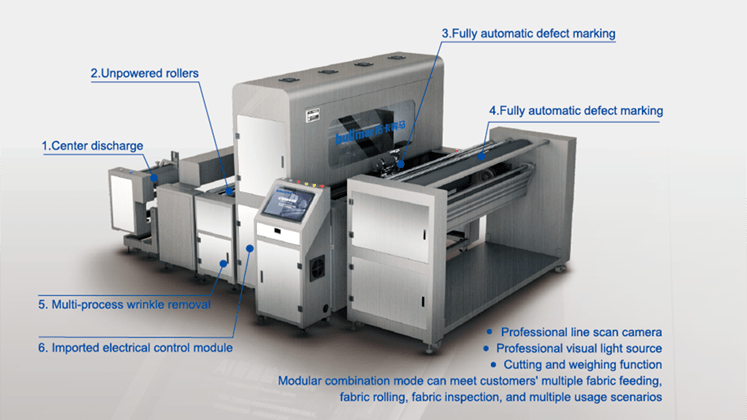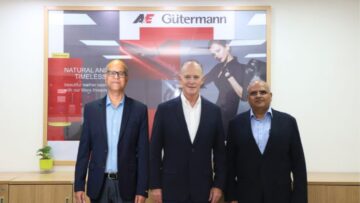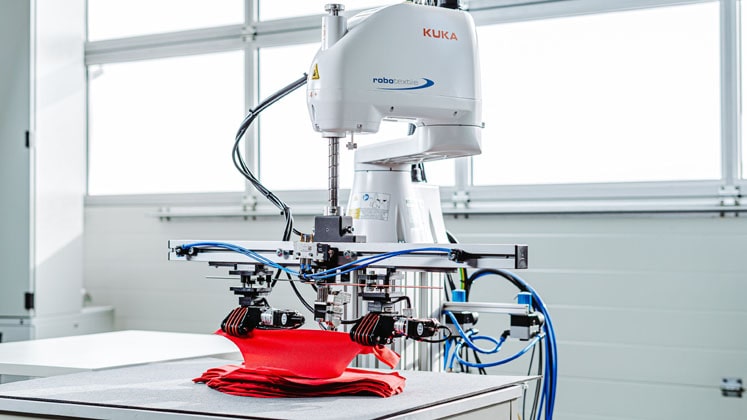
Industry 3.0 has proven to be a boon for industries such as aerospace, pharma, automobiles etc., however, apparel manufacturing industry hasn’t unlocked its true potential as of yet. When someone mentions about ‘automation’ in the apparel industry, the chances are high that most of the industry’s decision-makers still think it’s all about robots working on shopfloor which is not the case. By analysing hundreds of definitions of automation coined by different organisations and reports, one can sum up the following definition of automation in the context of manufacturing – “automation is the use of equipment to automate systems or processes. The end goal of manufacturing automation is to increase production capacity while reducing costs.”
So how can a manufacturing process be automated? There are technologies like Artificial Intelligence, Robotic Arms, Automatic Pick and Place Systems, Robotic Process Automation, Software Tools among many others that help scale up productivity while aiming to take tedious jobs away from humans. Apparel manufacturing, which is as complex as an industry can be, has huge scope for automation in processes like fabric inspection, cutting rooms, sewing floors, product inspection, garment measurement, packaging, finishing, washing and dispatching.
AI sets standards with automation in fabric inspection
The fabric inspection that has conventionally been done manually for decades is now seeing a major transition. The process is carried before the production of the garment takes place and now special equipment are replacing manual labour, automatically inspecting and classifying the fabric and counting the defects of the inspected fabric before storing the entire detailing for future access. The fabric inspection or fabric defect identification technology has been there for years now but only a few companies have gone beyond traditional technology to foray into AI-driven technology for the inspection of fabrics.
Artificial intelligence helps the apparel industry to overcome the high defective rate of clothing and textile factories due to fabric defects, high compensation rate and low manual recognition rate. The role of such AI-driven technology is even more important because manual identification information in fabric inspection process cannot be effectively transmitted and the industry cannot form realistic pain points such as unified standards, hence can’t reform it.
Bullmer – owned by China’s Jack Stock – marks its name as one of the first companies to launch a next-gen AI-driven intelligent technology – AI 01 – for the inspection of fabric. Continuous self-evolution in fabric inspection with AI-based patented Deep Model Self-Learning technology of Bullmer helps mills/factories in the complex fabric environment as the machines can learn more and more intelligence, automatically. The machine integrates a variety of image processing technologies and the advanced line scan uses an industrial camera to ensure the stability and anti-interference of imaging and detection.
AI-driven fabric defect identification technology comes with substantial benefits. Firstly, defect maps in fabrics can be directly formed using technology, and the data can be directly connected to factories’ management systems such as ERP, MES, etc., to facilitate judgment, management and problem handling. Secondly, fabric management standardisation becomes much easier. The AI-driven machine reduces the high defective rate of enterprises which generally arises due to fabric problems and reduction rate can be around 72 per cent -78 per cent. This is all achieved due to the standardisation of the defect identification parameters. Thirdly, the technology supports 24 hours of uninterrupted work and one fabric inspection machine can help reduce manual intervention of around four fabric inspection workers. The single-day fabric inspection using such technology can cross 20,000 metres in 10 hours of working.
Automation in cutting rooms
Gone are the days when automatic cutters in garment cutting rooms were used to cut the fabric layers only. Cutting technology suppliers have today imbibed AI and ML in their machines to upgrade and advance pre-production process which is obviously a need in today’s time when machine downtime can hamper productivity and on-time delivery drastically.
All the advanced cutters of the renowned France-based technology group Lectra come studded with hundreds of sensors which are able to crack when a failure is going to happen inside the machine. This prediction is done by collecting maintenance data and production data of the machine based on which Lectra can further find out if its customers are using that equipment on the optimal level. If they are not using it in the right way, Lectra, using the collected data, can figure that out and ask customers to use it in a much better way by changing some relevant parameters.
Similarly, Italy-based Morgan Tecnica believes its roots are firmly planted in Machine to Machine (M2M) communication as its automatic cutters are able to predict any possible breakdown in advance, such as knife breakage, or bearings failure. There are a number of sensors equipped in the new-age cutters that check the level of stress of the mechanics in the most critical area of cutter. With these sensors, the company informs its customers in advance that they should change their parts or suggests them that they are probably not working on right parameters such as the right set-up, speed and acceleration that may result in early breakdown in some components.
A leading US-based cutting technology giant Eastman Machine Company is also revolutionising the cutting technology as it’s embracing Industry 4.0 concepts – machine learning, M2M communication – in its auto-cutters. Eastman has synchronised technology which digitises the motion control totally. If something is getting defective or not working properly, the cutting machine gives a signal on the monitor in advance and the user knows that he has to replace the part. The company calls this ‘Robotic Indication System (ROI)’ that connects with the machine in such a way that it automatically tells which wiring is getting loose and it blinks on the monitor to inform about the defective part.
Automation on sewing floor – Automats, Pick and Place Systems
Sewbots – offered by the US company SoftWear Automation – made huge headlines a couple of years ago. It was a sewing line controlled by robots and aimed at sewing T-shirts without any human intervention. Despite grabbing some attention from the apparel industry from around the world, the company couldn’t scale up the commercialisation. The main reason is that the company couldn’t deploy robots in other products than T-shirts!
The fact is that the complete automation of the sewing process of a huge number of apparel commodities is still not available; however, there are certain innovations that serve almost the same purpose through advancements in the sewn industry. All these advancements highly aim at reducing human intervention which has become a necessity for factories as they should look to simplify arduous and complex processes which have always been carried conventionally through labour workforce.
One such innovation is Jack’s ‘Pick and Place’ system through robotic arm that the company has developed in collaboration with Huawei in its pattern sewer. In an exclusive demonstration, Team Apparel Resources (AR) learned that a robotic arm is attached to the pattern sewer and one operator can monitor three sewing machines at one time. “This robotic arm equipped with Jack’s pattern sewer is our answer to the people who are looking for robotic sewing in the clothing industry,” shared Jack’s official with Team AR.
The biggest advantage of this automatic pattern sewer is that it shows two different designs can be sewn by the same sewing machine. The sewing machine can visually identify the designs in the template and sew accordingly as a camera is fitted in the sewing head which decides the sewing pattern. As robotic arm gets inputs from the sewing head, it picks template from one sewing station and puts it on another, all automatically, saving enormous amount of the cost of operators, time and increasing productivity of the entire process.
The recent breakthrough development in the field of automation should be credited to Germany-based Robotextile GmbH that has developed four new gripper methods, which are capable of safely gripping almost all common textiles and fabrics and depositing them again very precisely. Single layers can be picked up in the same way as the top layer of a stack of garment cuts. Gripper A is for denim, cotton, shirts, suits; Gripper B is for stiff materials, mixed fibres and coated fabrics; Gripper C is for woven and knitted fabrics; while Gripper D is for underwear, statically charged fabrics and rolling edges.
Most of Robotextile’s grippers have built-in double-layer control and hold the textile in place by clamping as it moves. The grippers include the following physical methods: Coanda Venturi air flow, glue dot, rubber pinch roller, silicone finger, needle gripper and vacuum.
Italy-based Vibemac has also been a frontrunner in providing high-tech sewing automats for the apparel industry for over four decades now. What Vibemac, as a company, is doing is that it’s developing sewing stations with automatic loaders and unloaders. One such machine is pocket hemming machine V700/701. In the modified version (V700LDR) of this pocket hemming machine, an automatic feeding station with 4 automatic loading docks has been introduced. A specialised loading device can transfer the pockets to the transport belt through a robotic arm. And, once the pockets are hemmed, an un-loader automatically stacks the pockets, order-wise, on the storage disk at the end of the transport belt. This is ‘intelligent automation’ – as termed by Vibemac.
AMP Pisani automatic bra moulding machine is yet another example of how the manufacturing of bra has been innovated. AMP PISANI P88/4E is a flexible unit with four double molds. The pliers are specifically developed to mold bra cups in foam and it can produce eight cups per cycle. The machine has a movable plate with laser-cut shape which helps eliminate the creases in every deep cup or for low-density laminated foam. “Not all molding machines in the market have movable plates and that’s an added advantage for us,” commented Foo Toon Paw, Managing Director of Focus Garment Tech – dealer of AMP Pisani in South Asia.
Another engineered product offered by Focus Garment Tech is Keki JD-200; an automatic bra strap machine. The process of bra strap making is as easy as it could be. Once the process is started, the strap goes through an 8-buckle system which builds the size of the adjuster part into 40-120 mm. It just takes 4 seconds to complete one strap size of 400 mm while per hour productivity is 900 pieces.
Automation in Measurement Inspection
The garment measurement process is one such process which takes hundreds of man-hours to measure a huge number of garments in a factory on a daily basis, yet there is no certainty if the measurement is accurate and the passed garment won’t fail at the receiver’s end!
The high chances of human errors linked with the traditional measurement process create mind-bending situation most often for the quality inspectors. The certain challenges that a traditional apparel factory faces in the garment measurement process negatively impact the profitability. One of these challenges is high time consumption in the manual measurement system. The average time needed to hand-measure a single garment, record the data and enter the data into a computer programme hovers around 5 minutes. And, the time is even more if the product is too complex to measure.
Suppose a factory requires to measure 10,000 pieces, then around 50,000 minutes of the total garment inspectors are dedicatedly required which leads to only two solutions – 1) either increase the number of workers involved in the measuring process or 2) increase the number of days to conduct the process before it goes to the subsequent process. In both cases, the factory needs to take heavy indirect cost into their account while planning for a project. In garment QC process, inspectors spend, on an average, one-and-a -half to four hours a day simply keying in inspection data into Excel or PDF files.
Another issue is the high chances of human errors throughout the measurement process, as the traditional method of size measurement and data entry is prone to all kinds of human errors. Quality inspectors often calculate the deviation of actual measurements from its spec size before writing down the difference. This adds to the mental burden and exposes inspectors to the uninvited mistakes.
Access to data is the third major issue as the current method of size measurement and results in analogue data hinder the factory’s business from making correct, real-time decisions across various operations and this adds woes to the already flawed process. All these challenges can be solved with the introduction of the digital transformation of this entire garment measurement process and there are intelligent technologies available in the market that can solve these measurement problems.
A South Korean company – Bagel Labs – introduced Bagel Size Measuring Solution (ALT Smart Tape) sometime ago, and the same is offered by Sakho, a sister concern of the H&H group. The measuring solution utilises Bagel Labs’ proprietary smart tape measure technology to measure size digitally and send data directly to the computer via Bluetooth. The ‘smart’ tape can measure up to 160 cm (63 inches) and has an error range of just ±0.5 mm which makes it the world’s most accurate digital measuring tape, according to the company. Additionally, it is compatible with most of the ERPs and PLMs available as well as with Microsoft Excel.
The measurement process has also been innovated by Dongguan Yunji Zhihui Technology Co., Ltd., which is based in Dongguan High-tech Development Zone in China, is a high-tech industrial intelligent equipment developer and technical service provider. The company recently launched its high-tech garment visual inspection and measurement machine equipped with the vision system, which has filled the gap of the visual inspection system in the garment manufacturing industry.
The garment visual inspection machine uses computer-vision inspection system as the core technology, artificial intelligence (AI) as the engine and the integration of automated hardware mechanisms. The machine adopts assembly line design as reference. The tested T-shirts are laid on the machine belt/bed, and the parts that are not covered can be detected.
Once the garment product enters the machine, the screen, after 6 seconds, automatically shows the message – Pass/Fail, with all measurements. It can quickly and accurately detect the size of various parts of the clothing, T-shirts in particular, and can automatically identify and calculate errors. The machine can also automatically identify product information and generate various quality reports required by the apparel factories.
For example, if a T-shirt passes through the machine, it automatically measures the 15 dimensions of the T-shirts in maximum six seconds which are – collar width, collar depth, left shoulder width, right shoulder width, left sleeve length, right sleeve length, left sleeve width, right sleeve width, chest width, waist width, T-shirt length, T-shirt width, sleeve length symmetry, shoulder width symmetry and cuff width symmetry.
Automation in the Garment Folding Process
Conventionally, hundreds of workers used to spend hundreds of hours to manually fold the garments of different types on a daily basis in a typical export-oriented factory and the situation is no better even today despite the fact that automation has paved way for the betterment of a factory’s shopfloor processes.
Thermotron’s Automatic Folding Machine Line STP 1000 comes either as an autonomous unit or as part of a folding and bagging machines set and the machines are – STP 1000 (automatic folding machine), PV40 (automatic bagging machine) and KL60 (automatic sealing machine). The fully automatic line of machines needs only one operator and is capable of folding, bagging and sealing 5,500 garments in an eight-hour shift.
“The variety of garments is huge, and, for each garment, we have different reaction from the machine but our engineers have been able to make a line of machines that can be used to fold all type of casual garments like T-shirts, Polo Shirts, Sweaters, Jeans Bottoms,” commented George Paschalidis, Sales Manager, Thermotron. Thermotron also offers automatic stacking machine NT50 which is capable of stacking the already folded garments as they come from STP 1000.
Shenzhen Lingchuang Automated Technology Co. Ltd. has been focusing on automatic garment folding and packing technology for more than a decade now. The company, with over 40 patents and a production capacity of more than 400 machines annually, is equipped with a state-of-the-art R&D centre where it invests in cutting-edge innovation and customization.
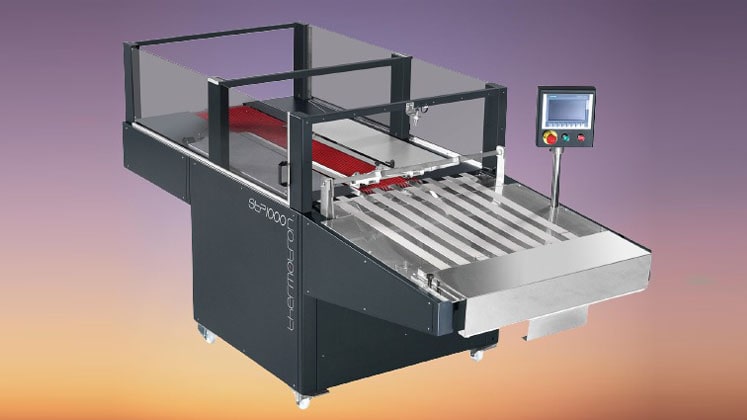
The series of packing machines use only one worker to manually feed the garments (knits and trousers) and the folding, packing and sealing is done automatically for an efficient packing process and gives desired productivity. The average packing speed of the machine is 500-700 pieces per hour which is around 5000 pieces per day, hence increasing packing efficiency and minimising manpower in manual folding and packing of garments. The leading Chinese machines are approved by world-renowned brands such as Nike, Uniqlo, Adidas, Anta, H&M, Gap, Super Dry etc., as claimed by the company.
The list is incomplete without mentioning Portugal-based ROQ that offers the ROQfold automatic folding machine that’s said to fold any kind and shape of clothing such as T-shirts, sweatshirts, polos – short or long sleeves – trousers, skirts, dresses, etc. The secret to this flexibility of folding different products is its three folding stations – sleeves, body and final fold. ROQfold has two configurations: (1) with 3 folding stations (2) without the sleeves folding station, making the machine to occupy less space on the factory premises. However, the company advises to use this second configuration to fold T-shirts only.
The machine uses just one operator to load the piece and then the machine itself carries the rest of the processes. The only two requirements for the smooth process are: the initial configuration of the lengths of the folds and the type of folds (depending on the dimensions and type of the pieces) after which the automated process takes place.
The processing speed of ROQfold is 700 pieces/hour which can vary depending on the size and type of the garment that’s loaded in the machine. The speed of the machine is defined by the loader so that the work is properly done.
Automating 25,000+ hours of Manual Work – Levi Strauss’s Way
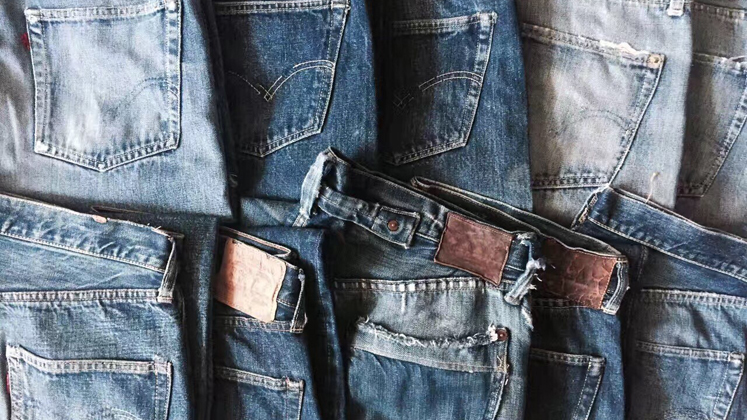
Popular denim brand Levi’s has scaled up its automation programme drastically. The Levi Strauss & Co. Robotic Process Automation (RPA) Center of Excellence (COE) team set out to automate nearly 25,000 hours of tedious work by the end of 2022 with 45 in-house bots.
These bots alleviate the burden of monotonous tasks like data entry and data validation, and ultimately allow employees to spend time on more analytical work. From IT and merchandising to distribution and logistics, the RPA COE team has worked with functions across the organisation and throughout the globe to help balance workloads and improve efficiency and accuracy.
“In late 2021 and early 2022, I embarked on a mission to educate LS&Co., about the power of automation, and I think with the results of 2022, we have proven the benefit. Now it is a question of how far we can go,” said Stacie Clarkson, Senior Director of Process Transformation and Global Business Services Governance and Lead of the RPA COE.
Stacie further commented that the brand has created automation ambassadors across the company, and beating its internal goal by nearly 5,000 hours is proof that there are major benefits the workforce can take advantage of. Levi’s has even more work underway and plans to automate at least 45,000 hours of work by the end of 2023.
Its global product development team was among the many functions that tapped into the RPA COE services in 2022. The Levi’s® brand is a full head-to-toe lifestyle brand that offers staples like fresh graphic tees each season. Normally, the product development team would be responsible for combing through thousands of graphic tee product codes and cross-referencing them in its digital asset management tool, ensuring all the information and visuals are accurate and included in the briefs before sending to its manufacturing partners — a task that would take hours.
The RPA COE team, in partnership with the product development team, developed a bot that would vet and validate the thousands of product briefs and flag those that needed some form of reconciliation like accurate file types or missing visual links. The team could now focus on fixing the problems rather than searching for the problems.
“With the bot developed by our RPA team, our team is saving nearly 450 hours a year, and we’re able to be much more efficient and effective in our validation process,” said Jonathan Hsieh, Manager of Product Development at Levi Strauss.

